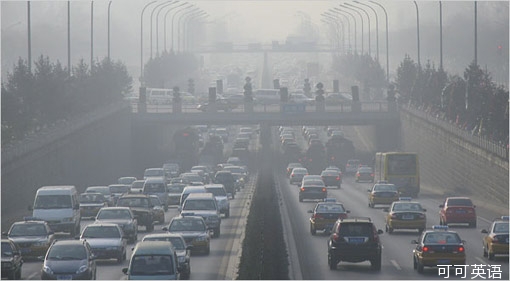(单词翻译:单击)

Breathing particulate-laden (aka smoggy) air may be hardening your arteries faster than normal, according to research published today in PLOS Medicine. While everyones’ arteries harden gradually with age, a team of researchers led by epidemiologist Sara Adar of the University of Michigan School of Public Health discovered that higher concentrations of fine particulate air pollution were linked to a faster thickening of the inner two layers of the carotid artery.
根据今日发表在《公共科学图书馆·医学》杂志上的研究,呼吸含大量颗粒物的(雾霾)空气可能会让你的动脉硬化速度加快。尽管每个人的动脉都会随着年龄增大而逐渐硬化,但密歇根大学公共卫生学院的流行病学家萨拉·阿达领导的研究团队发现,空气中的细微颗粒污染物浓度升高与颈动脉内膜和中膜增厚加快有关。
Because the carotid artery feeds blood to the neck, head, and brain, a narrowing or blockage there can trigger strokes. And general atherosclerosis, or hardening of the arteries, is a major risk factor for cardiovascular disease, heart attack, and heart failure.
由于颈动脉要向颈部、头部和大脑供血,颈动脉变窄或堵塞可能会引发中风。通常动脉硬化是冠心病、心脏病发作和心力衰竭的主要风险因素。
Past research has demonstrated that the rates of stroke and heart attack are higher in polluted areas, but experts haven’t been able to pinpoint just how polluted air is raising peoples’ risk for heart attack or stroke. This time, Adar’s team, along with Joel Kaufman, professor of environmental and occupational health sciences and medicine at the University of Washington, was able to directly measure carotid artery thickness and link it to air pollution data.
以往的研究已经表明,在受污染地区中风和心脏病发作的几率更高,但专家还未能查明空气污染是如何提高人们心脏病或中风发作的风险的。这次阿达带领的团队和华盛顿大学环境与职业健康科学和医学专业的教授乔尔?考夫曼联手合作,已经能够直接测量颈动脉厚度,并将其和空气污染数据联系起来。
The study involved 5,362 people between the ages of 45 and 84 living in six different cities that are part of the MESA AIR (Multi-Ethnic Study of Atherosclerosis and Air Pollution) research project, led by Joel Kaufman. Each participant underwent two carotid artery ultrasounds three years apart. These measurements were then correlated with data on fine particulate air pollution.
乔尔·考夫曼领导的这一动脉硬化和空气污染多种族研究项目调查了居住在6个不同城市、年龄在45岁到84岁之间的5362个人。每个参与者隔三年都要做一次颈动脉超声波检查。研究人员把这些测量结果和细颗粒物空气污染的数据联系起来。
While the artery walls of all participants increased by 14 micrometers per year, the arteries of those who were exposed to higher levels of fine particulate air pollution in their homes thickened faster than their neighbors in other parts of the city.
尽管所有参与者的动脉壁每年都会增厚14微米,但那些家周边空气中细颗粒污染物水平更高的人动脉壁比住在同城其他地区的人增厚速度更快。
Interestingly, the researchers also found the reverse effect to be true: reducing fine particulate air pollution levels slowed down atherosclerosis progression. Carotid artery measurements are considered by experts to be an indicator for arterial plaque and hardening throughout the body.
有趣的是,研究人员还发现反之亦然:降低空气中的细颗粒污染物水平会减慢动脉硬化的速度。专家认为颈动脉的测量数据是动脉斑块和周身硬化的指示标志。


